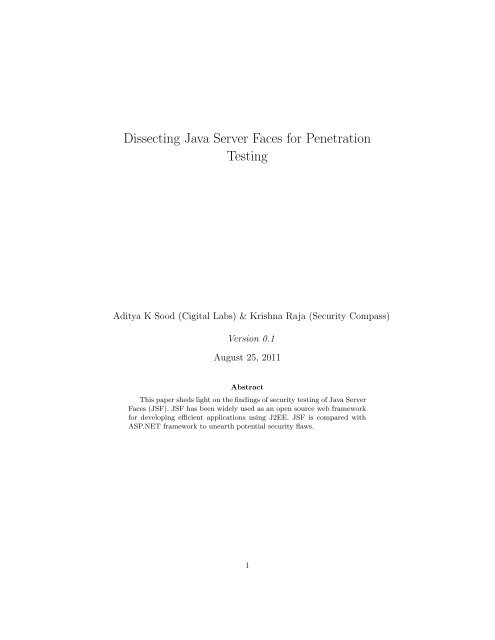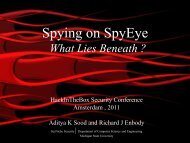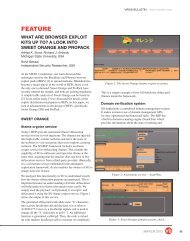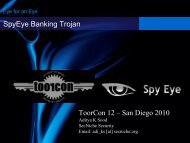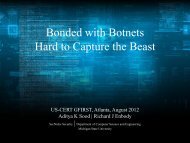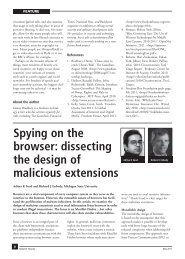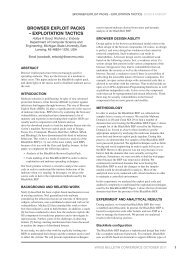Dissecting Java Server Faces for Penetration Testing - SecNiche ...
Dissecting Java Server Faces for Penetration Testing - SecNiche ...
Dissecting Java Server Faces for Penetration Testing - SecNiche ...
- No tags were found...
Create successful ePaper yourself
Turn your PDF publications into a flip-book with our unique Google optimized e-Paper software.
<strong>Dissecting</strong> <strong>Java</strong> <strong>Server</strong> <strong>Faces</strong> <strong>for</strong> <strong>Penetration</strong><strong>Testing</strong>Aditya K Sood (Cigital Labs) & Krishna Raja (Security Compass)Version 0.1August 25, 2011AbstractThis paper sheds light on the findings of security testing of <strong>Java</strong> <strong>Server</strong><strong>Faces</strong> (JSF). JSF has been widely used as an open source web framework<strong>for</strong> developing efficient applications using J2EE. JSF is compared withASP.NET framework to unearth potential security flaws.1
Contents1 Acknowledgments 32 Overview 43 Inside JSF Framework 53.1 JSF Security Architecture . . . . . . . . . . . . . . . . . . . . . . 53.1.1 JSF <strong>Faces</strong>-Config.xml and Web.xml . . . . . . . . . . . . 64 <strong>Penetration</strong> <strong>Testing</strong> JSF Framework 74.1 JSF ViewState Anatomy . . . . . . . . . . . . . . . . . . . . . . 74.1.1 Differential Behavior - ViewState in ASP.NET and JSF . 74.2 Scrutinizing Padding - <strong>Testing</strong> Oracle . . . . . . . . . . . . . . . 94.2.1 Experiment - Fuzzing Oracle . . . . . . . . . . . . . . . . 114.3 JSF Anti CSRF - Truth Behind the Scenes . . . . . . . . . . . . 114.3.1 Implementing CSRF Protection - The Right Way . . . . . 134.4 Security Descriptors Fallacy - Configuration . . . . . . . . . . . 144.4.1 Secure Way of Configuring Security Descriptors . . . . . . 154.5 JSF Version Tracking and Disclosure . . . . . . . . . . . . . . . . 164.6 JSF Data Validation . . . . . . . . . . . . . . . . . . . . . . . . . 164.6.1 JSF 1.2 Validation . . . . . . . . . . . . . . . . . . . . . . 164.6.2 JSF 2.0 Validation . . . . . . . . . . . . . . . . . . . . . . 174.6.3 Custom Validations . . . . . . . . . . . . . . . . . . . . . 185 Conclusion 206 About the Authors 217 References 222
1 AcknowledgmentsWe would like to thank couple of our friends and security researchers who helpedus in shaping this paper.• Giorge Maone (NoScript)• Juliano Rizzo (Netifera)In addition, we would also like to thank Gary McGraw <strong>for</strong> providing usefulinsight into the paper. A sincere gratitude to all the researchers who are engagedin constructive research <strong>for</strong> the security community. Lastly, we sincerely wantto thank our security teams at <strong>SecNiche</strong> Security Labs and Security Compassrespectively <strong>for</strong> supporting us in doing security research.3
2 OverviewIn present times, software security has become an indispensable part of softwaredevelopment life cycle. The penetration testing approach varies with respect toweb development frameworks and plat<strong>for</strong>ms. With the advent of advanced levelof attacks, it has become crucial to raise the standards of penetration testing.An aggressive security testing approach is required to detect the inherent vulnerabilitiesand to develop robust security solutions in order to thwart sophisticatedattacks. Owing to the seamless pace of security research, a plethora of vulnerabilitiesare being unearthed in web frameworks and software. Thus, <strong>for</strong> effectivepenetration testing, the security model and web framework architecture shouldbe dissected appropriately.OWASP has been used widely as the de facto standard of penetration testingof web applications and frameworks with its Top 10 attack vectors. However,the penetration testing methodology should not be constrained to this standardand must cover the advanced set of attack vectors that should be tested to validatethe strength of web frameworks.This paper is divided into two parts. In the first part, we discuss the internalsof JSF, a <strong>Java</strong> based web application framework and its inherent security model.In the second part, we discuss about the security weaknesses and applied securityfeatures in the JSF. In addition, we also raise a flag on the security issues presentin JSF in order to conduct effective penetration testing.4
3 Inside JSF Framework<strong>Java</strong> <strong>Server</strong> <strong>Faces</strong> (JSF) is an industry standard and a framework <strong>for</strong> buildingcomponent-based user interfaces <strong>for</strong> web applications. JSF has certain standardsand is implemented using Reference Implementation (RI) by Sun Microsystems,Apache My<strong>Faces</strong> and Oracles ADF <strong>Faces</strong>. JSF primarily consists of <strong>Java</strong> Beans,Event Driven development and JSF component tree.With the advent of JSF, the control has been handed over to the developers<strong>for</strong> implementing security features such as authorization. As a result ofthis change, it has become more crucial <strong>for</strong> the developers to understand theimplementation of security controls in JSF framework. A good security designpractice requires that authorization (security controls) should be handled at acentral location (Servlet Filter associated with the application front controller).JSF has built-in extension points provided by the JSF architecture. As JSFhas no proprietary security architecture, the security has to be imposed in acustomized fashion. This is usually done in two ways• The developer can design a custom ViewHandler that adds security checks<strong>for</strong> createView and restoreView. However, it is not considered as the bestsecurity practice because there is no guarantee that the custom securityViewHandler is executed be<strong>for</strong>e the default ViewHandler. This leads tosecurity exceptions while handling requests from the web clients• The developer can design a phaseListener that adds security definitions torestoreView and invokeAction phases. This can be implemented in JSFfaces-config.xml file or the developer can do it dynamically by writing acustomPhase listener.3.1 JSF Security ArchitectureJSF is used <strong>for</strong> designing web based rich internet applications over the J2EEframework. <strong>Java</strong> applications are mostly designed using Model, View, and Controller(MVC) architecture due to the need <strong>for</strong> real time deployment. J2EEsecurity can be implemented through <strong>Java</strong> Authentication and AuthorizationService (JAAS) and container-managed security. JAAS implements fine-grainedaccess control through external <strong>Java</strong> permission classes, which provides user witha list of resources and allowed actions. Be<strong>for</strong>e J2EE, the security controls wereimplemented within the logic itself. J2EE framework has a declarative securitymechanism in which security controls are applied through web.xml deploymentdescriptors which in turn are handled by the J2EE container at runtime. Incontainer managed security, controls are applied using authorization which isexplicitly en<strong>for</strong>ced on the URL patterns (requests that are issued by the webclient).Generally, the controller is responsible <strong>for</strong> implementing security controlswhereas the view and model part are used <strong>for</strong> hiding in<strong>for</strong>mation and applyinglogic based on the access roles of the user respectively. However, a good design5
practice suggests that the security should be implemented over all three layers.as presented in figure 1.Figure 1: MVC - Model View and Controller ArchitectureJSF has implemented the concept of validators which can be used to verifyuser input at a view level and model level.3.1.1 JSF <strong>Faces</strong>-Config.xml and Web.xmlThe rich life cycle of various individual phases are explicitly specified in the facesconfig.xmlfile. Some of the events included in the file are Restore View, ApplyRequest Values, Process Validation, Update Model Values, Invoke Application,and Render Response. Developers should always consider the fact that facesconfig.xmlfile has no mention of security and all security constraints must bespecified in web.xml file.6
understood. In ASP.Net, the ”ViewStateEncryptionMode.Auto” mode isset by default which decides whether a specific web page has to have anencrypted ViewState or not in order to reduce the processing load. However,it is always advised to encrypt the full ViewState in every webpageby declaring the ””property. This ensures that ViewState data could not be retrieved.• In ASP.NET, Message Authentication Code (MAC) is also computed bydefault and appended in the base 64 encoding in order to avoid the tamperingof ViewState with arbitrary data. The biggest problem in implementingMAC is that it has to be explicitly specified on the webpage withthe ”enabledViewStateMac” parameter to be true otherwise MAC is notenabled by default. It is advised that the MAC key should be larger in sizein order to reduce the attack surface. Usually, the GUID of the machineis used as a MAC key.Some of the generic ViewState decoders which fail in JSF may work fine inASP.NET ViewState decoding. ViewState decoder designed by plural-sight [2]fails <strong>for</strong> JSF and works fine <strong>for</strong> ASP.NET as it only works in .NET environment.Figure 2 shows that tool raises red alert while handling JSF ViewState andshould not be used <strong>for</strong> the analysis of JSF ViewState.Figure 2: ViewState Decoder Fails <strong>for</strong> JSF8
Netifera group has also released a tool termed as POET [3] which shouldbe used <strong>for</strong> testing ViewState in JSF. Figure 2 shows the successful decodingof ViewState in JSF. However, some of the data is gzipped which can be furtherunzipped fully. Even this in<strong>for</strong>mation raises an alert about the insecureimplementation of ViewState in JSF.Figure 3: Successful Decoding of ViewStateOne can also use the Deface [4],[5] tool <strong>for</strong> testing ViewState in JSF whichis released by SpiderLabs <strong>for</strong> aggressive testing of JSF framework.4.2 Scrutinizing Padding - <strong>Testing</strong> OracleWith the advent of new technologies, more sophisticated attack patterns arebeing noticed in the routine life. Last year, the discovery of padding oracle attacks[6] has dismantled the implementation of encryption in web frameworks.9
a large scale. A number of websites using JSF in a real time environment arestill vulnerable and are running in default insecure state. The ViewState encryptionstrength in JSF can be checked using POET as discussed. The toolverifies whether the encryption is applied or not. If it is applied, then it has aninbuilt module to decrypt the ViewState using oracle padding. The tool followsthe concept of tampering a single byte in the encrypted JSF ViewState (lastblock) to verify whether ViewState padding is done appropriately or not basedon HTTP error fingerprinting. JSF usually ignores the inserted block duringserialization which helps the tool to go on decrypting the ViewState withoutany hassles. The practical usage of tool can be seen here [9].4.2.1 Experiment - Fuzzing OracleWe conducted a number of tests on one of the vulnerable websites to show theimpacts of the padding oracle. The tests are based on manual fuzzing. The aimis to present the variation in the error responses when encrypted ViewState istampered. One thing that should be taken into account while per<strong>for</strong>ming thistest is that ViewState has to be encrypted. The test should not be executedagainst ViewState that is compressed using GZIP. In addition, the ViewStateshould be fuzzed using multiples of 8 because the block size that is used in CBCencryption has a similar technique. The nature of a response to a padded buffervaries between applications.Step 1: Injecting random buffer in ViewState as a multiple of 8. Figure 5shows how the application reacts.Step 2: At this point, we got a crypto padding error in step 2, on continuousplaying around with padding in ViewState; we received different error aspresented in figure 6.Considering this scenario, one can continue fuzzing the request, until it isaccepted by the application. There is a typical way of doing padding in CBCand that can be used in all scenarios as discussed here [11]. One can opt <strong>for</strong>various methods to pad CBC encryption.4.3 JSF Anti CSRF - Truth Behind the ScenesIn reality, JSF does not have an aggressive built-in CSRF protection. AntiCSRF support is required <strong>for</strong> protection against Cross Site Request Forging(CSRF) attacks. However, the implementation of anti CSRF depends a lot onthe design of he in the required framework. ViewState is used <strong>for</strong> preserving thestate of web pages and can be used in conjunction with another configurationparameters to prevent CSRF attacks. However, one can per<strong>for</strong>m certain logictests to initially detect whether the application is vulnerable to CSRF attacksor not.11
Figure 5: Fuzzing Request / Error in Block SizeGenerally, if the ViewState is implemented on the server side, then it is agood security practice that the application should send a ViewState ID token asa hidden element in the HTML tag so that it can accompany legitimate requestsfrom the client side. If the application is only implementing ViewState on theserver side and is not using any ViewState ID, then it is possible that CSRF isnot handled appropriately. Tokens generated by using ”javax.faces.ViewState”(sequential) are easy to guess if not encrypted properly.Listing 2: Implementing ViewState Tracking on <strong>Server</strong> SideAs presented in listing 2, the j id2 parameter is set <strong>for</strong> the ViewState trackingon the server side. The attacker designs the next request in that session withViewState id as j id3, j id4 and so on which will be treated as legitimate by theserver. In Apache My<strong>Faces</strong> ”org.apache.myfaces.NUMBER OF VIEWS IN SESSION”has a default value of 20 where as IBM Web sphere ”com.sun.faces.numberOfViewsInSession”has 15. These parameters specify the number of views that are stored in thesession when server side state saving is used.NOTE: In JSF, it is considered that ViewState can be used to prevent CSRF12
Figure 6: Fuzzing Request / Error in Last Blockattacks when collaboratively used with the JSESSIONID. As we have been discussing,ViewState implementation matters a lot. Now it has become possible tore encrypt the tampered ViewState and deliver it back to the server. EncryptingViewState and sending data over HTTPS are not the protection mechanismsagainst CSRF attacks. This has been widely misunderstood in the developercommunity.4.3.1 Implementing CSRF Protection - The Right WayStrong CSRF implementation in JSF can be implemented as• Applying Anti CSRF filters such as ”org.apache.catalina.filters.CsrfPreventionFilter”.The inbuilt class uses the ”java.util.Random” if explicitly specified by thedeveloper otherwise ”java.security.SecureRandom” will be used by default.One can also use OWASP CSRF Guard to integrate third party filters intoJSF.• If the ViewState session Id is to be used with every request then it mustbe strongly encrypted and an appropriate MAC should be applied in order13
to preserve integrity.• It is also possible to design custom CSRF filters with strong functionsthat generate random tokens. This is possible by creating a CSRF Sessionlistener class that overrides every request with HTTP listener class andappends a random token in every request <strong>for</strong> a particular session. Thereis also a possibility of adding an element in thetag that automatically initiates the CSRF protection. Framework thatsupports are Apache Shale, My<strong>Faces</strong> and JBOSS Seam.• The real world examples will look like as presented in listing 3Listing 3: Implementing CSRF Tokens in JSF4.4 Security Descriptors Fallacy - ConfigurationThe declaration of security parameters in web.xml are imperative especially thesecurity elements that are used <strong>for</strong> preserving the confidentiality and integrityof the ViewState. It has been noticed that declaration of ”ALGORTIHM” inuppercase in ”org.apache.myfaces.ALGORITHM” does not initialize the InitializationVector (IV) in Apache My<strong>Faces</strong>. This is a bad design practice and couldhave devastative impacts on the security of a JSF application. The source codeof the ”utils.StateUItils” class (which holds security configuration elements) aspresented in listing 4 which clearly reflects that these parameters have to be appliedin lower case but the documentation of various JSF versions is not writtenappropriately and is not inline with the real code. In other words, the documentationis misleading.p u b l i c s t a t i c f i n a l S t r i n g INIT PREFIX = ” org . apache . myfaces . ” ;p u b l i c s t a t i c f i n a l S t r i n g INIT ALGORITHM = INIT PREFIX + ”ALGORITHM” ;p r i v a t e s t a t i c S t r i n g findAlgorithm ( ExternalContext ctx ) {S t r i n g a l g o r i t h m = ctx . g e t I n i t P a r a m e t e r (INIT ALGORITHM) ;i f ( a l g o r i t h m == n u l l ){a l g o r i t h m = ctx . g e t I n i t P a r a m e t e r (INIT ALGORITHM .toLowerCase ( ) ) ;}r e t u r n findAlgorithm ( algorithm ) ;}. . Truncated . .Listing 4: Explicit Specification - Implementing to Lower Case14
4.4.1 Secure Way of Configuring Security DescriptorsThe best practice is to declare the configuration parameters in web.xml as presentedin listing 5.javax . f a c e s .STATE SAVING METHODc l i e n t org . apache . myfaces . s e c r e t MDEyMzQ1Njc4OTAxMjM0NTY3ODkwMTIzorg . apache . myfaces . algorithm AESorg . apache . myfaces . a l g o r i t h m . parameters CBC/PKCS5Paddingorg . apache . myfaces . a l g o r i t h m . iv NzY1NDMyMTA3NjU0MzIxMA==org . apache . myfaces . s e c r e t . cache false Listing 5: Secure Way of Declaring Encryption Parameters in JSFThis point should be taken into account while doing penetration testing so thatenhanced attacks can be tested against the inappropriate implementation ofJSF security.NOTE: It has been noticed that JSF framework only encrypts ViewState inorder to provide confidentiality but there is no standard implementation of MACby default so that the integrity of ViewState is preserved. While we know thatJSF security greatly depends on the web.xml file, the MAC functionality is alsointroduced in it. The developer has to explicitly specify the MAC algorithm,key and caching.The parameters that are used nowadays are ”org.apache.myfaces.MAC ALGORITHM”,”org.apache.myfaces.MAC SECRET” and ” org.apache.myfaces.MAC SECRET.CACHE”respectively. Always declare all of these parameters in lower case.15
4.5 JSF Version Tracking and DisclosureJSF configuration has inbuilt configuration parameters that are used to disclosethe version of the installed framework. However, it is always taken lightly andis not fixed by the developers or administrators to avoid leakage of the in<strong>for</strong>mationin HTTP response headers. It has been noticed that version disclosure mayresult in detecting critical flaws in JSF applications because publicly availableexploit databases can be used to fingerprint the security vulnerabilities presentin the installed JSF framework.In Suns RI JSF implementation, the ”com.sun.faces.disableVersionTracking”configuration parameter is defined explicitly. By default, it is set to false whichmeans application running on the web server will throw the JSF version intothe response headers when the web client queries <strong>for</strong> it. The collaborativedisclosure of web server version and framework version can be devastative fromthe developers point of view but it is fruitful <strong>for</strong> pen testing purposes. JSFis not immune to security vulnerabilities [12, 13, and 14] as seen in the recentpast. These security issues should be taken into consideration while deployingJSF applications because in<strong>for</strong>mation leakage is the basis of a number of webattacks. We conducted generic tests on several websites that are using JSF andfound that more than 85% of the websites are throwing JSF version numberin their response headers out of which several of them were running old andvulnerable versions.4.6 JSF Data ValidationAnyone involved in security understands the importance of proper input validation.JSF offers a few different techniques <strong>for</strong> validation in order to preventweb attacks such as Cross Site Scripting (XSS). Some of the input validationmodules have been available since JSF 1.2, and others are unique to JSF 2.0.4.6.1 JSF 1.2 ValidationApache My<strong>Faces</strong> and the Apache Tomahawk library provide JSF componentsthat can allow <strong>for</strong> data validation within the UI page itself. One of the morepowerful ways of validating input is by leveraging regular expressions via the¡t:validateRegExpr¿ tag provided by Tomahawk [15]. Consider an examplewhere we wish to validate a ZIP code. A My<strong>Faces</strong> example of data validationusing Tomahawk [16] is presented in listing 6.Listing 6: Generic My<strong>Faces</strong> Example - Tomahawk16
In this particular example, a regular expression is being used to limit the zipcode to five digits. Notice that you can include an error message as well, and allof this is done within the .xhtml page itself. A similar example using Facelets[17] is presented in listing 7.Listing 7: Generic Facelets ExampleThe JSF Reference Implementation (RI), codenamed ”Mojarra”, comes withits own tag library that also leverages regular expressions. Mojarra’s will per<strong>for</strong>m the same operation as discussed above. Furthermore,Mojarra’s tag library is armed with an tovalidate the proper <strong>for</strong>mat of credit cards [18].4.6.2 JSF 2.0 ValidationJSF 2.0 contains a collection of tags called validators. These are built in to theJSF 2.0 core library. JSF developers will find the following tags particularlyuseful <strong>for</strong> data validation:• : use this to validate that input falls between a minimumand maximum length• : use this to validate that numeric input fallsbetween a minimum and maximum value• : similar to validateLongRange, but used <strong>for</strong>double values• : use this to leverage regular expression validationHere is an example of JSF validators in use as presented in listing 8.User ID : User ID :Listing 8: Generic Usage of JSF Validators17
Notice in the above example that the contains a required,requiredMessage and validatorMessage attribute. The required attribute indicatesthat this value must be input by the end user and an error message isdisplayed if it is not provided.4.6.3 Custom ValidationsAll of the above approaches work well when the values are not tied closely tobusiness logic, or if these validators and tag libraries are suitable to per<strong>for</strong>mthe validation we need. Sometimes there is a need to build custom validationcomponents <strong>for</strong> data types that arent supported by standard JSF validators[19].In this scenario, the validator attribute of the tag referencesa validator method that is defined within the bean class [20] as presented inlisting 9.Bid Amount : Bid Amount : $Listing 9: Example : Bid Bean ClassIn the BidBean2 class, we would define our custom validation method aspresented in listing 10, validateBidAmount():p u b l i c void validateBidAmount ( <strong>Faces</strong>Context context , UIComponentcomponentToValidate ,UIComponent componentToValidate , Object value ) throwsV a l i d a t o r E x c e p t i o n {double bidAmount = ( ( Double ) value ) . doubleValue ( ) ;double p r e v i o u s H i g h e s t B i d = c u r r e n t H i g h e s t B i d ( ) ;i f ( bidAmount
As we can see, this approach allows more flexibility while validating inputdata. The validators play a significant role in curing many security vulnerabilitiesat the source level.19
5 ConclusionIn this paper, we have presented the security issues in JSF architecture. Webframeworks have unique semantics and security models. A thorough understandingof the internal architecture of the frameworks is imperative to undertakeproductive penetration testing. We have discussed the advance featuresthat should be tested <strong>for</strong> complete and extensive penetration testing of JSF.In general, JSF is similar to ASP.NET from security perspective but differs indeployment of inherent security controls. Every web framework is required tobe dissected so that step by step testing can be per<strong>for</strong>med in a robust manner.20
6 About the AuthorsAditya K Sood is a Senior Security Practitioner and PhD candidate at MichiganState University. He has already worked in the security domain <strong>for</strong> Armorize,COSEINC and KPMG. He is also a founder of <strong>SecNiche</strong> Security Labs,an independent security research arena <strong>for</strong> cutting edge computer security research.He has been an active speaker at industry conferences and already spokenat RSA, HackInTheBox, ToorCon, HackerHalted, Source, TRISC, AAVAR,EuSecwest, XCON, Troopers, OWASP AppSec USA, FOSS, CERT-IN, etc. Hehas written content <strong>for</strong> Virus Bulletin, HITB Ezine, Hakin9, ISSA, ISACA,CrossTalk, Usenix Login, and Elsevier Journals such as NESE and CFS. He isalso a co author <strong>for</strong> debugged magazine.He is also associated with Cigital Labs <strong>for</strong> doing applied security research in thefield of software and application security.Email: adi ks [at] secniche.orgPersonal Website: http://www.secniche.orgCompany Website : http://www.cigital.comKrishna Raja is a Senior Application Security Consultant at Security Compasswith an extensive background in <strong>Java</strong> EE application development. He hasper<strong>for</strong>med comprehensive security assessments <strong>for</strong> financial, government, andhealth care organizations across Canada and the United States. Krishna hascarried out the role of security advisor, security analyst, project manager andtrainer. He has given lectures and taught courses at RSA, Source Boston, ISSASecure San Diego and OWASP AppSec DC. Krishna graduated from the Universityof Western Ontario in 2004 with an Honors BSc. in Computer Sciencewith Software Engineering specialization. He is also an ISC2 Certified SecureSoftware Lifecycle Professional (CSSLP).Email: krish [at] securitycompass.comCompany Website: http://www.securitycompass.com21
7 References[1] Apache <strong>Java</strong> <strong>Server</strong> <strong>Faces</strong>, http://myfaces.apache.org/[2] ViewState Decoder, http://www.pluralsight-training.net/community/media/p/51688.aspx[3] POET Tool, http://netifera.com/download/poet/poet-1.0.0-win32-x86.jar[4] Deface Tool, https://github.com/SpiderLabs/deface[5] Beware of Serialized GUI Objects Bearing Data, http://www.blackhat.com/presentations/bhdc-10/ByrneDavid/BlackHat-DC-2010-Byrne-SGUI-slides.pdf[6] Padding Oracle Attacks, http://www.usenix.org/event/woot10/tech/full papers/Rizzo.pdf[7] Cryptography in the Web: The Case of Cryptographic Design Flaws inASP.NET, http://www.ieee-security.org/TC/SP2011/PAPERS/2011/paper030.pdf[8] Automated Padding Oracle Attacks with PadBuster, http://www.gdssecurity.com/l/b/2010/09/14/automated-padding-oracle-attacks-with-padbuster/[9] Cracking ViewState Encryption in JSF, http://www.youtube.com/watch?v=euujmKDxmC4[10] Microsoft Patch Padding Oracle Attacks, http://www.microsoft.com/technet/security/bulletin/ms10-070.mspx[11] Using Padding in Encryption, http://www.di-mgt.com.au/cryptopad.html[12] Sun <strong>Java</strong> <strong>Server</strong> <strong>Faces</strong> Cross-Site Scripting Vulnerability, http://www.securityfocus.com/bid/28192[13] Apache My<strong>Faces</strong> Tomahawk JSF Framework Cross-Site Scripting (XSS)Vulnerability , http://labs.idefense.com/intelligence/vulnerabilities/display.php?id=544[14] Sun Glassfish Enterprise <strong>Server</strong> - Multiple Linked XSS vulnerabilies,http://dsecrg.com/pages/vul/show.php?id=134[15] My<strong>Faces</strong> Tomahawk, http://myfaces.apache.org/tomahawk/index.html[16] Tomahawk ValidateRegExpr, http://www.developersbook.com/jsf/myfaces/tomahawktag-reference/tomahawk-validateRegExpr.php#1[17] Facelets, http://facelets.java.net/[18] JSF Majorra Extension Tags Validation and Focus, http://java.sys-con.com/node/103173322
[19] JSF Validation Tutorial, http://www.mastertheboss.com/web-interfaces/293-jsf-validation-tutorial.html?showall=1[20] JSF: Validating User Input, http://courses.coreservlets.com/Course-Materials/pdf/jsf/08-Validation.pdf23


